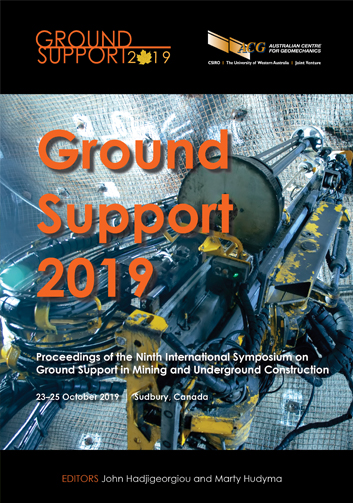The creation and application of a geotechnical block model for an underground mining project

|
Authors: Sewnun, D; Joughin, W; Wanless, M; Mpunzi, P |
DOI https://doi.org/10.36487/ACG_rep/1925_34_Sewnun
Cite As:
Sewnun, D, Joughin, W, Wanless, M & Mpunzi, P 2019, 'The creation and application of a geotechnical block model for an underground mining project', in J Hadjigeorgiou & M Hudyma (eds), Ground Support 2019: Proceedings of the Ninth International Symposium on Ground Support in Mining and Underground Construction, Australian Centre for Geomechanics, Perth, pp. 479-492, https://doi.org/10.36487/ACG_rep/1925_34_Sewnun
Abstract:
The collection and analysis of geotechnical data forms the basis for understanding the geotechnical characteristics and the overall quality of the rock mass in a mining environment. While the use of statistics can provide an impression of the average rock mass quality across a project area, it does not assist with a detailed understanding of the way in which data may be spatially related. With the introduction of geostatistics, the spatial continuity of a dataset may be investigated. This may be carried out with the use of semi-variograms. Once the spatial continuity of a dataset is understood, geostatistical methodologies may be applied to create a geotechnical block model. This paper focuses on the creation of a geotechnical block model which provides a three-dimensional visual representation of rock mass data (in varying levels of confidence) across a project area. This concept is illustrated using a case study where geostatistics is adopted to estimate the rock mass quality across a proposed mining area by applying the appropriate geostatistical methodologies between geotechnical boreholes. A holistic impression of the rock mass conditions is given by the model, whilst also providing insight on areas where poor rock quality and associated potential instabilities can occur. This study also brings to light the importance of collecting reliable data during the geotechnical logging process, as the success of any geotechnical block model is highly dependent on the input data that the geostatistics is applied to. If created with careful consideration it is believed that geotechnical block models are valuable tools which can be continually updated as more data is gathered as mining progresses.
Keywords: geotechnical block modelling, geostatistics, rock mass quality, rock mass classification
References:
Barton, N, Lien, R & Lunde, J 1974, ‘Engineering classification of rock masses for the design of tunnel support’, Rock Mechanics, vol. 6, pp. 189-536.
Bye, A 2006a, ‘The application of multi-parametric block models to the mining process’, Proceedings of the International Platinum Conference: Platinum Surges Ahead, The Southern African Institute of Mining and Metallurgy, Johannesburg, pp. 259–266.
Bye, A 2006b, ‘The strategic and tactical value of a 3D geotechnical model for mining optimization, Anglo Platinum, Sandsloot open pit’, The Journal of The South African Institute of Mining and Metallurgy, vol. 106, pp. 97–104.
Jenkins, P & Seymour, C 2009, ‘Mining rock mass models: 3D evaluation of the geotechnical environment for optimal project design and planning’, AusIMM Journal, iss. 6.
Luke, DA and Edwards, A 2004, ‘Geotechnical block modelling at BHP Billiton Cannington Mine’, in E Villaescusa & Y Potvin (eds), Proceedings of the Fifth International Symposium on Ground Support, A.A. Balkema, Rotterdam, pp. 129–138.
Sewnun, D, Pillay, O & Wanless, M 2017, ‘Geotechnical block modelling for the 3-dimensional visualisation of rock mass quality in the mining environment’, Proceedings of the 9th South African Young Geotechnical Engineers Conference, pp. 1–10.
© Copyright 2026, Australian Centre for Geomechanics (ACG), The University of Western Australia. All rights reserved.
View copyright/legal information
Please direct any queries or error reports to repository-acg@uwa.edu.au
View copyright/legal information
Please direct any queries or error reports to repository-acg@uwa.edu.au